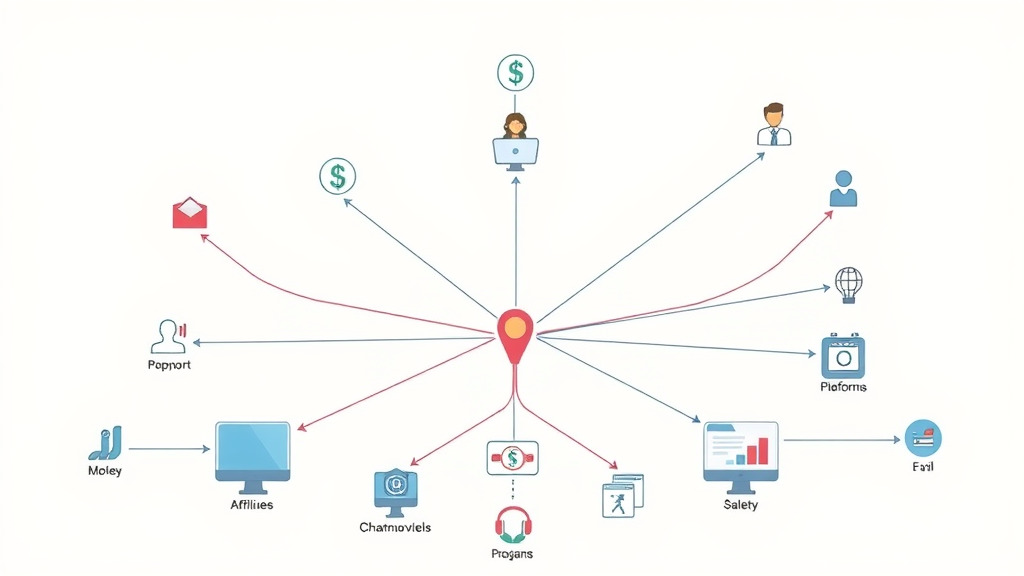Did you know? Affiliate marketing spending is expected to surpass $13 billion in the U.S. alone this year. If you’re searching for affiliate marketing platforms that can transform your side hustle into a sustainable business, you’re not alone. In this comprehensive guide, you’ll discover how the world’s top affiliate networks are revolutionizing online income, which platforms offer the highest earning potential, and insider tips for maximizing your commissions. Ready to unlock your income potential?
Breaking Records: Why Affiliate Marketing Platforms Are Transforming Online Earnings
The exponential growth of affiliate marketing platforms is reshaping how individuals and businesses capitalize on online opportunities. With billions pouring into the affiliate space, platforms like Amazon Associates , CJ Affiliate , and ShareASale dominate the landscape, offering access to a wide range of products and services. These platforms empower both seasoned experts and newcomers to rapidly scale income with minimal upfront investment, making affiliate marketing one of the most accessible paths to earning online today.
Affiliate networks don’t just connect merchants with affiliate marketers; they offer robust marketing programs, automated tracking, and fair commission structures that incentivize partners to drive results. With sophisticated dashboards, advanced reporting tools, and proactive support, these marketing networks foster an environment where motivated content creators and website owners can thrive—no matter their niche.
A Glimpse Into the Explosive Growth of Affiliate Networks
The surge in affiliate networks is driven by efficiency and data-driven decision-making. Statistics show that affiliate marketing spending is expected to surpass $13 billion in the U.S. alone this year . This incredible growth is mirrored by the increasing number of brands and publishers joining top affiliate platforms to tap into scalable, performance-based revenue streams. Today’s networks leverage advanced technology, making affiliate programs more transparent, reliable, and profitable than ever before. Marketers worldwide are leveraging analytics dashboards to optimize their campaigns, targeting both physical products and digital products for maximum ROI.

"Affiliate marketing spending is expected to surpass $13 billion in the U.S. alone this year."
What You'll Learn: Mastering Affiliate Marketing Platforms for Profit
- Discover the top affiliate marketing platforms trusted by leading affiliate marketers
- How the best affiliate networks leverage advanced marketing programs for scalable revenue
- Actionable strategies to join and optimize affiliate program success
- Data-driven comparisons of affiliate marketing programs and networks
Affiliate Marketing Platforms: The Core of Modern Affiliate Programs
At the heart of every successful affiliate marketing program sits a reliable affiliate platform or network. These digital bridges connect merchants with motivated affiliate partners , transforming how online brands grow their reach. The evolution of affiliate networks has brought about more sophisticated features, diverse commission structures, and greater opportunities for marketers to earn through both product-based and service-based affiliate programs .
Understanding your options is crucial. Whether you’re interested in a marketing network focused on digital products or a traditional affiliate network prioritizing physical goods, the best platforms offer tools for tracking, reporting, and communication. With the right combination of transparency and support, these platforms have become the foundation of modern online business growth and passive income streams.
Defining Affiliate Network, Affiliate Platform, and Marketing Program
An affiliate network is a marketplace connecting affiliates with numerous advertisers running multiple marketing programs . An affiliate platform often provides a proprietary space for brands to build direct relationships with their affiliate marketers, offering unique tools and tracking technology to elevate performance. Meanwhile, the term marketing program typically refers to the individual arrangement or campaign you join within these networks or platforms. Understanding the distinctions—and how they interweave—will help you select the right vehicles for your earning goals.

- Key functions and features of affiliate networks
- How affiliate platforms shape the affiliate marketing industry
Types of Affiliate Marketing Programs and Their Unique Benefits
Affiliate marketing isn’t one-size-fits-all. Product-based affiliate programs (think Amazon Associates) allow you to promote physical goods, earning a commission on every sale made through your affiliate links . Service-based programs (such as SaaS or coaching platforms) often offer higher, recurring commissions for driving signups or subscriptions. There are even niche affiliate networks dedicated to specific verticals, making it easier for marketers to reach highly targeted audiences with tailored content.
- Distinguishing between product-based and service-based affiliate programs
- Understanding niche affiliate networks for targeted marketing
| Platform | Main Niche | Key Features | Payment Terms | Affiliate Support |
|---|---|---|---|---|
| Amazon Associates | Physical Products | Global reach, instant trust | Net 60 | Comprehensive help center |
| CJ Affiliate | All niches | Premium partners, in-depth analytics | Net 30 | Active account management |
| Rakuten Advertising | Retail/International | Marketplace access, campaign tools | Net 30 | Email/chat support |

Criteria for Choosing the Best Affiliate Network or Platform
With so many affiliate networks and platforms available, narrowing down the best fit for your goals requires a strategic approach. You’ll want to consider commission structures , payment frequency, network reliability, and the tools provided to help you track your progress. For many affiliate marketers , joining more than one platform can further diversify income and minimize risk.
Evaluating Commission Structures and Payment Methods in Affiliate Networks
Commission structure is king in affiliate marketing. Some programs offer fixed commissions—such as a set dollar amount per sale—while others pay a variable commission based on product price, volume, or performance tier. Recurring revenue opportunities, like those found in SaaS or subscription-based programs, can provide long-term income stability. Meanwhile, the frequency and reliability of payouts (weekly, monthly, net-30, net-60) directly impact your cash flow and planning. Make sure you understand the details before signing up with a new marketing platform .
- Fixed vs. variable commissions in affiliate marketing programs
- Frequency and reliability of payouts across marketing networks
Affiliate Support, Tracking Technology, and Partner Network Reliability
Leading affiliate programs and marketing networks now offer powerful real-time dashboards and analytical tools, enabling you to track clicks, conversions, and earnings seamlessly. Comprehensive support—whether through dedicated account managers, responsive help desks, or active community forums—makes a big difference, particularly as you scale. Reliability in tracking technology and payment processing is vital for building long-term trust and success.
- Assessing real-time dashboards and reporting tools
- How effective marketing platforms enable growth for affiliate marketers

The Top 15 Affiliate Marketing Platforms Ranked for Maximum Earnings
1. Amazon Associates: The Iconic Affiliate Network
- Global reach and breadth of product categories in the Amazon affiliate program
Amazon Associates stands out for its unparalleled selection of physical products and trusted brand reputation. No matter your content niche, you can find a product to recommend. Its simple setup and broad market appeal make it a favorite among beginners and pros alike, though commission rates tend to be lower and payouts occur every 60 days.
2. CJ Affiliate (Commission Junction): Advanced Affiliate Marketing Network
- Premium partner network and data-driven marketing programs
CJ Affiliate , also known as Commission Junction , boasts a powerful dashboard, detailed analytics, and access to hundreds of big brand partners. Its rigorous application process ensures quality on both sides, making it a premier choice for experienced affiliate marketers seeking long-term partnerships with high-paying advertisers.
3. Rakuten Advertising: Award-Winning Affiliate Platform
- Superior marketplace access and affiliate program management tools
Rakuten Advertising provides access to international brands and advanced campaign management tools. The network is known for excellent reliability and a secure partner network, ideal for marketers targeting international audiences or looking to expand into new verticals.
4. ShareASale: Versatile Affiliate Marketing Network for Diverse Niches
- Thousands of marketing programs and digital products
ShareASale supports a massive catalog of merchants, ranging from digital products to physical goods. Its intuitive reporting tools and flexible commission models make it accessible for niche bloggers and established affiliates alike.
5. eBay Partner Network: Marketplace Affiliate Program for E-Commerce
- Specialized commission structure and affiliate marketer resources
The eBay Partner Network enables publishers to earn by linking to millions of eBay listings. Its unique commission structure and diverse inventory offer flexibility, especially for content creators focused on collectibles, tech gadgets, or deals.
6. Impact: Innovative Marketing Platform for Advanced Affiliates
- Customizable affiliate marketing programs with robust analytics
Impact is recognized for its customizable tracking, sophisticated dashboards, and partnerships with global brands. Advanced features attract skilled marketers looking for automation, real-time insights, and scalable marketing programs.
7. FlexOffers: Expansive Affiliate Platform for Publishers
- Extensive array of products, services, and affiliate networks
FlexOffers aggregates thousands of affiliate programs , from banking and travel to clothing and electronics. Its platform makes it easy to manage multiple offers, making it a top choice for content creators running several sites or verticals.
8. Awin: Global Affiliate Marketing Platform for Digital Growth
- Cross-border marketing network and performance tracking tools
Awin serves more than 200,000 publishers worldwide. With a focus on user-friendly performance tracking, cross-border marketing, and timely payments, it’s a robust option for both new and established international affiliate marketers.
9. ClickBank: Leading Affiliate Network for Digital Products
- Optimized for info-products and recurring commission programs
ClickBank specializes in digital products—think eBooks, online courses, or membership sites. Generous commission rates and quick payments make it a favorite for marketers in online education, fitness, and personal development niches.
10. PartnerStack: Partner Network for SaaS and B2B Marketers
- Innovative affiliate program solutions for marketing programs
PartnerStack targets SaaS and B2B brands, allowing affiliates to promote powerful business solutions for recurring monthly or annual commissions. Its robust partner network ensures transparency and seamless management for all parties involved.
11. Pepperjam: Specialized Affiliate Marketing Platform for Retail
- Emphasis on brand control and digital products
Pepperjam empowers retailers with direct-to-consumer capabilities, brand control, and multi-channel tracking for digital products . Marketers benefit from advanced tech and strategic guidance.
12. Avangate Affiliate Network: Focused on Software and SaaS
- Dedicated support for digital product affiliate marketers
Avangate (now 2Checkout) specializes in software and subscription-based services. Affiliates receive generous commissions and dedicated support, making it a solid choice for technology-focused content creators and SaaS marketers.
13. Admitad: Global Affiliate Marketing Program Hub
- Diverse verticals and localized affiliate networks
Admitad enables affiliates to partner with global brands across a range of niches. Its localized approach and wide marketing network make it suitable for international marketers aiming for tailored campaigns.
14. Partnerize: Data-Driven Marketing Networks for Enterprise
- Automation tools and cross-network reporting
Partnerize caters to enterprise brands with advanced automation and unified reporting across multiple affiliate networks . Its sophisticated infrastructure is ideal for big brands seeking granular control.
15. Refersion: User-Friendly Affiliate Platform for Brands
- Direct-to-consumer focus with advanced marketing networks
Refersion streamlines affiliate management for ecommerce businesses, offering simple dashboards, customizable links, and robust support. It suits brands wanting to build direct affiliate partnerships .
| Platform | Average Monthly Traffic | Payout Frequency | Main Verticals |
|---|---|---|---|
| Amazon Associates | 1B+ | Net 60 | All products |
| ClickBank | 10M+ | Weekly | Digital products |
| CJ Affiliate | 100M+ | Net 30 | All niches |

Case Studies: Success Stories from Affiliate Marketers
"My earnings quadrupled after switching to a specialized affiliate platform tailored to my niche." - Top Affiliate Marketer
Case Study: Maximizing Earnings with Social Media & Affiliate Networks
- Leveraging social media for multi-network affiliate marketing success
A lifestyle blogger integrated affiliate links from multiple platforms—like CJ Affiliate and eBay Partner Network—into their content and amplified reach using social media campaigns. By driving targeted traffic from Instagram and Pinterest to product roundups, she saw a dramatic spike in both clicks and completed sales. Diversifying across more than one affiliate network , and utilizing social proof, multiplied commissions and built trust with her audience.

Case Study: High Earnings with Digital Product Affiliate Marketing Programs
- Strategy breakdown of high-producing digital marketers
An online educator capitalized on digital product affiliate marketing programs via networks like ClickBank, focusing on high-value e-courses and recurring membership sites. By producing in-depth content and email funnels centered around audience needs, he unlocked recurring commissions and built a passive income stream. His secret: mixing detailed product reviews with authentic case studies and comparison guides—maximizing conversions and growing trust through transparency.
Video Walkthrough: How to Join Leading Affiliate Marketing Platforms
Step-by-Step Visual Guide for Signing Up and Getting Started
Joining your preferred affiliate platform is easier than ever. Start by researching affiliate programs aligned with your website’s audience. Complete the application with accurate info, ensuring your content adheres to the platform’s quality guidelines. Once approved, explore your dashboard, pull affiliate links , and integrate them into your blog, YouTube videos, or social media. Regularly check reports to optimize performance and test new strategies for growth.

Maximizing Profits: Insider Tips for Affiliate Marketing Platforms
Strategic Platform Selection Based on Marketing Network Niches
- How to choose the right affiliate marketing platform for your audience
- Importance of marketing programs tailored to your website or traffic source
To truly boost your earnings as an affiliate marketer, select affiliate marketing platforms that dovetail with your audience’s interests and content type. For instance, bloggers focused on gadgets and tech will benefit from networks offering brands in electronics. Similarly, content creators in the SaaS or software space should look to partner networks with robust B2B marketing programs . Your success hinges on this alignment.
Combining Affiliate Programs for Multi-Platform Revenue Streams
- Aligning affiliate marketing efforts with digital products and services
Don’t keep all your eggs in one basket. Revenue multiplies when affiliate marketers promote offers from several affiliate platforms and networks . By combining product-based and service-based programs, you can cross-sell, upsell, and cater to multiple audience segments. Use analytics to tweak your efforts, measure conversion rates, and identify the combinations that yield the highest profits. This multi-network strategy not only diversifies your risks but also reveals new opportunities for growth.
| Strategy | Avg Monthly Earnings | Risk Level | Scalability |
|---|---|---|---|
| Single Network | $500–$2,000 | High (Platform Changes) | Limited |
| Multi-Platform | $2,000–$10,000+ | Low (Diversified) | High |

Common Mistakes to Avoid When Using Affiliate Marketing Platforms
- Ignoring platform policies, failing to track conversions, or joining non-reputable networks
- Overlooking the importance of affiliate program support and resources
Many new affiliate marketers overlook crucial factors such as keeping up with changing platform policies, implementing conversion tracking, or vetting the credibility of new affiliate networks. Choose only reliable, established networks and regularly review platform terms to safeguard your income streams. Don’t underestimate the impact of quality support, readily available resources, and transparent communication from your affiliate programs—these are all essential for solving issues and scaling your income efficiently.

Video Explainer: How Major Affiliate Networks Set Their Commission Rates
Understanding Commission Calculation in Prominent Affiliate Programs
Most affiliate programs set commission rates based on product or service type, average order value, competition in the vertical, and desired marketing outcomes. For example, Amazon Associates sets fixed rates by category, while SaaS networks might offer recurring commissions to incentivize ongoing referrals. The best affiliate platforms are transparent about how rates are determined, helping affiliates plan and prioritize their promotional strategies for maximum ROI. Always review the payout structure when joining or scaling any program.
Frequently Asked Questions on Affiliate Marketing Platforms
What is the best platform for affiliate marketing?
The best platform varies depending on your niche and audience. Amazon Associates is known for its vast product selection, while CJ Affiliate offers high-end partners. ClickBank is best for digital products. Consider your content, traffic sources, and which network provides the tools and commissions that match your needs.
Can you make $100 a day with affiliate marketing?
Yes, many affiliate marketers earn $100 or more daily, but reaching that level may require consistent traffic, high-converting content, and diversified revenue streams across multiple affiliate programs . Focusing on targeted audiences and optimizing your marketing programs can help achieve this milestone.
What is the highest paying affiliate program?
SaaS and finance verticals often feature the highest commission rates , sometimes paying hundreds or thousands per conversion. Networks like PartnerStack , ClickBank (for high-ticket digital products), and specific private programs consistently lead in payouts for top performers.
Which is the best website for affiliate marketing?
There’s no single “best” website; success depends on factors like niche focus, content quality, and audience engagement. Blogs, review sites, YouTube channels, and even social media accounts can become top-earning affiliate websites if they match the right audience with relevant offers from reputable platforms.
Expert Quotes: Driving Results with Affiliate Marketing Platforms
"Diversifying across multiple affiliate networks enables affiliate marketers to maximize their earnings and stability."

Comprehensive List: Resources for Joining Top Affiliate Marketing Platforms
- Official links to leading affiliate networks and program registration pages
- Guides, community forums, and marketing networks for ongoing support
For those ready to take action, visit each affiliate platform’s official registration page to get started. Join online communities, read platform guides for best practices, and participate in marketing networks to stay ahead of trends and maximize your affiliate earnings potential.
Video Tutorial: Affiliate Marketing Platform Optimization Techniques
Implementing Advanced Tracking and Reporting Across Multiple Affiliate Programs
- Ensuring seamless integration and streamlined performance analysis
To optimize performance, leverage advanced tracking tools that allow you to monitor clicks, conversions, and earnings across all platforms in real time. Integrate analytics from each network into a centralized dashboard, set up automated performance reports, and use custom tracking parameters to isolate your top-performing affiliate links. This data-driven approach ensures you can make informed decisions and continually improve your campaigns.

Key Takeaways from the Best Affiliate Marketing Platforms Today
- Choose a platform that aligns with your niche, audience, and content strategy
- Diversify across multiple affiliate networks to minimize risk and maximize earnings
- Leverage advanced analytics and affiliate support for continual improvement
Unlock Your Earning Potential: Sign Up with Leading Affiliate Marketing Platforms
- Explore top-rated affiliate networks and marketing programs
- Start your affiliate marketer journey and boost your income today
Take action: Analyze your content, select 2-3 top affiliate marketing platforms from this list, join today, and implement the strategies you’ve learned to transform your online earnings.
Affiliate marketing platforms serve as essential bridges between merchants and marketers, facilitating partnerships that drive online sales and revenue. Among the leading platforms, ShareASale stands out with over 4,500 affiliate programs, offering a diverse range of products and services across various niches. Its user-friendly interface and comprehensive resources make it a preferred choice for many affiliates. ( marketingscoop.com )
Another prominent platform is CJ Affiliate (formerly Commission Junction), which boasts a vast network of advertisers and provides advanced tracking tools and detailed reporting. This makes it ideal for affiliates seeking robust solutions and partnerships with established brands. ( bixgrow.com )
For those interested in digital products, ClickBank offers a specialized marketplace with generous commission rates, often up to 75% or more. Its focus on digital goods like e-books and software appeals to affiliates targeting online audiences. ( medium.com )
Awin , previously known as Affiliate Window, provides access to over 25,000 merchants, including renowned brands like Under Armour and Warby Parker. Its global reach and diverse advertiser base make it a versatile option for affiliates. ( evolup.com )
Rakuten Advertising (formerly Rakuten Marketing) is another key player, offering a broad range of partnerships, especially popular in the fashion and beauty niches. Its international platform connects affiliates with a variety of brands, enhancing earning potential. ( medium.com )
When selecting an affiliate marketing platform, consider factors such as the range of available merchants, commission structures, payment terms, and the support provided. Aligning these elements with your niche and audience can significantly enhance your affiliate marketing success.
 Add Row
Add Row  Add
Add 




Write A Comment